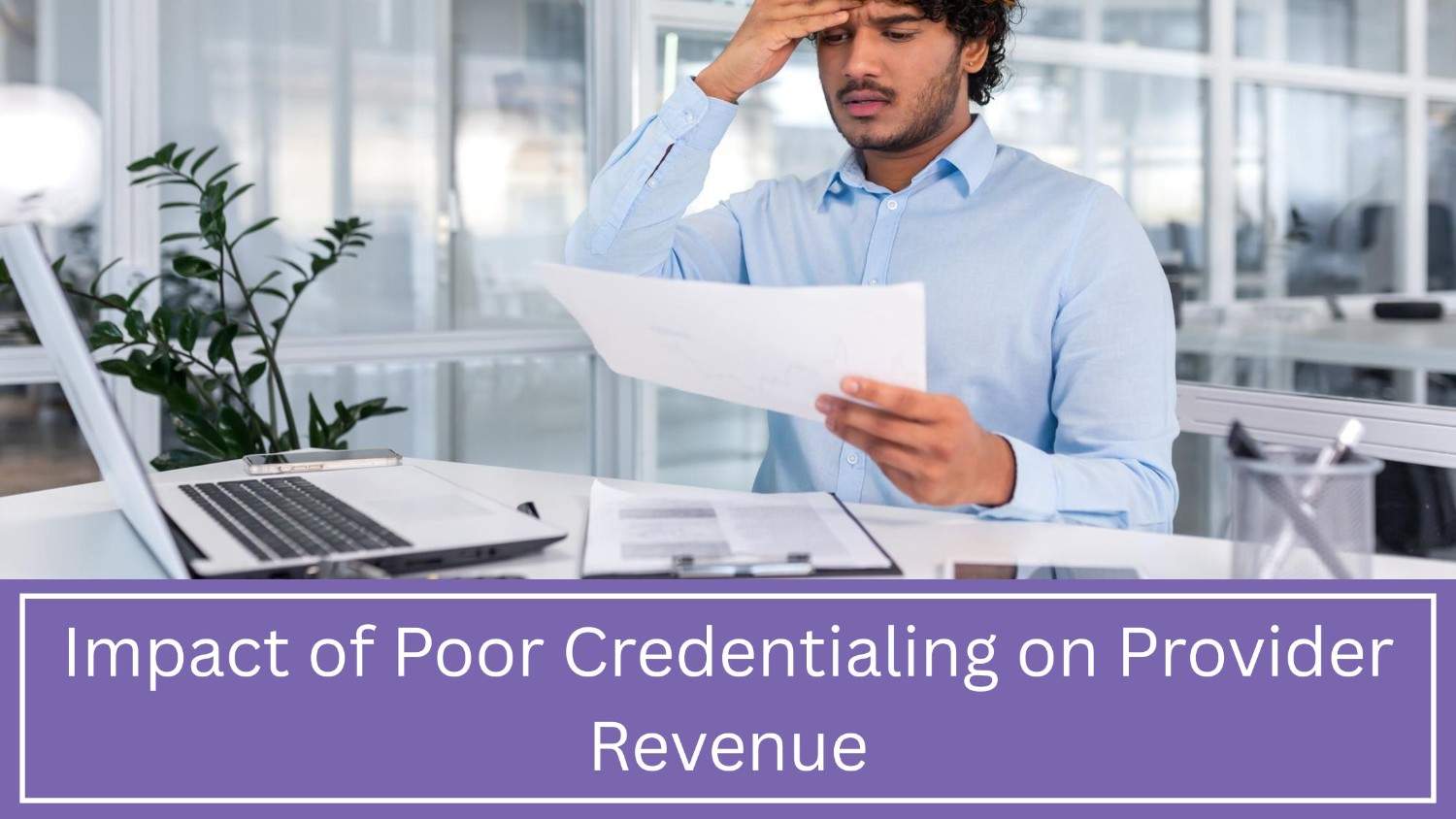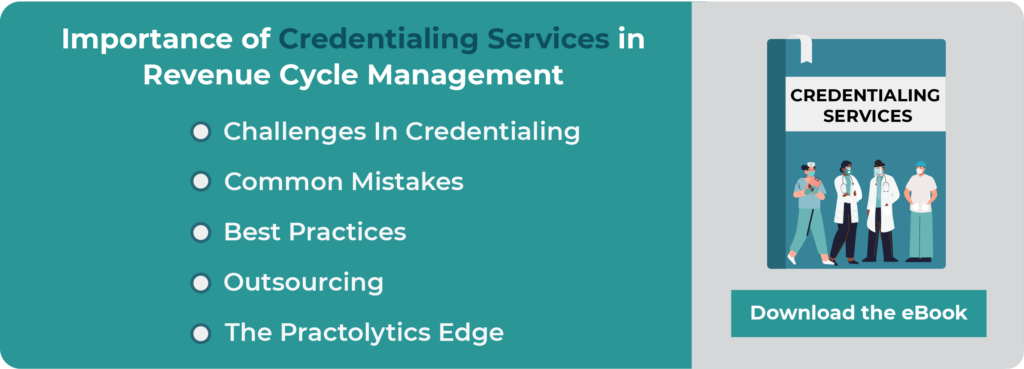Impact of Poor Credentialing on Provider Revenue
Billing errors aren’t the only reason for unpaid or delayed reimbursements. The impact of poor credentialing on provider revenue is often overlooked but can be just as damaging. When provider credentialing is incomplete, inaccurate, or delayed, claim denials rise, cash flow slows, and compliance challenges increase. In this article, explore how credentialing inefficiencies affect revenue, what causes these setbacks, and how advanced solutions like automation and CVO partnerships can transform the process. Discover how top healthcare organizations accelerate provider onboarding and achieve faster, error-free approvals—with Practolytics as your trusted credentialing partner.
Table of Contents
Impact of Poor Credentialing on Provider Revenue
You might think billing mistakes cause most payment delays in healthcare. But there’s a bigger problem: poor credentialing. Every doctor must be checked and approved by insurers before they can bill and get paid. When credentialing is slow or wrong, it hurts your whole cash flow.
A new MGMA survey shows credentialing delays cost new doctors up to 25% of their first-year earnings. That’s a big loss for growing practices—especially those hiring new doctors or moving to new states.
Let’s look at how poor credentialing hits your money, why it happens, and how to fix it.
What Is Provider Credentialing, and Why Does It Matter?
Credentialing is how we check a provider’s background—their licenses, training, and work history. Once cleared, we enroll them with insurers so claims get paid.
Plainly: No credentialing means no medical billing and no income.
The steps:
- Gather provider documents
- Confirm licenses and certifications
- Submit insurer applications
- Wait for approvals (often 60–120 days)
If mishandled? Providers get stuck. They can’t bill for months.
The Revenue Domino Effect of Poor Credentialing
Credentialing problems spread fast and hurt your business. Here’s how they damage your money flow and daily work:
1. Slow Onboarding Means Lost Billing.
Payers must approve providers before you can bill. Missing paperwork or delays mean claims get rejected.
Result: You lose billing days fast. If a provider sees 20 patients daily but waits 60 days for approval, they miss hundreds of billable visits.
2. Denied Claims, Lost Cash
If a provider isn’t enrolled correctly, claims get denied automatically. Even if you fix it later, most payers won’t pay for services before the approval date.
Result: Permanent money loss. CMS and private insurers rarely pay for late approvals.
3. Administrative Chaos
Scattered credentialing causes lost paperwork, missed deadlines, and forgotten renewals. This slows approvals and invites errors.
Impact: Exhausted teams, wasted time, and unreliable records.
4. Compliance Risks
Outdated or incomplete credentials fail audits. Providers working without valid credentials threaten the entire business.
Impact: Fines, suspended contracts, or lawsuits.
5. Negative Cash Flow
Revenue halts when payers stall claims. But payroll, rent, and daily costs continue. Slow credentialing creates cash shortages.
Impact: Stalled growth and less investment in patient care.
The Data: How Big Is the Credentialing Problem?
Recent reports highlight a major business challenge:
- 75% of healthcare executives rank payer credentialing as a top administrative headache. (Source: HFMA, 2024)
- Standard enrollment takes 90–120 days, but mistakes can push it beyond 180 days.
- Delays cost practices $9,000–$15,000 monthly per provider. (AAPC, 2023)
- 85% of enrollment setbacks stem from incomplete or inaccurate provider details.
These numbers prove credentialing isn’t just red tape—it’s a revenue engine requiring speed and accuracy.
Why Credentialing Errors Happen
Even experienced billing teams hit credentialing snags. Here’s why:
1. Manual Mess
Spreadsheets and email checklists mean dropped details and forgotten steps.
2. Chaos Without Consistency
Each payer and state has unique forms, rules, and deadlines. No single system? Total disorder.
3. Limited Staff Time
Medical Credentialing takes too long. Staff juggle billing, HR, and admin tasks—they can’t focus enough.
4. Communication Gaps
When providers, payers, and credentialing teams don’t sync up, requests get lost. Every delay adds weeks.
5. No Live Tracking
Without dashboards or alerts, you can’t see application statuses. This causes repeat work and missed deadlines.
The Financial Chain Reaction
Let’s visualize the impact step-by-step:
|
STAGE |
POOR CREDENTIALING OUTCOME |
EFFECT ON REVENUE |
|
Provider Onboarding |
Incomplete forms or missing documents. |
Onboarding delayed by 30–60 days |
|
Payer Enrollment |
Application rejected or returned |
Claims held or denied |
|
Claim Submission |
Provider not listed as active |
Zero payment |
|
Rework & Appeals |
More admin time and resubmissions. |
Increased labor cost |
|
Delayed Cash Flow |
Payments pushed back 90+ days |
Loss of operational stability |
Over time, these delays can drain thousands of dollars per provider and frustrate both staff and patients.
2025 Trends in Credentialing Efficiency
Healthcare organizations see credentialing as vital now—not just paperwork. New tech and outsourcing are reshaping how it’s done.
1. Automation Steps In
AI tools scan applications fast. They catch missing info and errors before submission. This cuts turnaround by 40%.
2. Clear Dashboards Lead
Real-time dashboards show every provider’s status—new, pending, or approved. Leaders act quickly with this visibility.
3. Centralised Credentialing Teams (CVOs)
More multi-state medical groups now hire CVO partners to handle all credentialing tasks. These experts manage compliance, verify credentials at the source, and enroll providers with payers—slashing wait times.
4. Smart Timeline Planning
Analytics predict which states or payers cause delays, helping teams schedule provider onboarding smarter.
5. Scale Without Bottlenecks
Using specialized CVOs lets practices grow quickly. Add new providers fast—keep revenue flowing without slowdowns.
Best Practices to Prevent Credentialing Delays
Here’s how leading healthcare practices dodge credentialing delays:
- Begin Early: Initiate credentialing 90–120 days before a provider joins.
- Standardize Tools: Use checklists for uniform paperwork across states.
- Centralize Records: Keep licenses and certificates in one secure hub.
- Monitor Progress: Track every provider’s status via real-time dashboards.
- Verify Rigorously: Always confirm details with primary sources—no shortcuts.
- Pursue Persistently: Check weekly with payers until approvals land.
- Renew Ahead: Set alerts months before renewals expire—never lapse.
Real-World Example: How a CVO Cleared Backlogs Fast
A multi-state clinic group had 120 pending credentialing cases. Insurance delays and poor tracking caused months-long backlogs. After hiring a specialized credentialing team, they achieved:
- Cleared all 120 backlogs in 6 months
- Credentialed new providers 21 days faster
- Started billing on time, increasing monthly revenue
- Saved staff 500 admin hours
By outsourcing credentialing to experts, they turned slow growth into steady expansion.
Key Takeaway: Credentialing Is the First Step of Revenue
Credentialing kicks off your revenue cycle. Get this wrong, and claims, billing, and payments stall. Smart credentialing tools or partners aren’t optional—they’re vital for your bottom line.
Conclusion: Practolytics—Your Partner for Faster Credentialing and Revenue Growth
Poor credentialing wastes time and money and strains payer relationships—hurting patient care. The fix? Simple. Practolytics helps healthcare groups streamline credentialing, slash A/R days, and stop revenue leaks. They use automation, payer partnerships, and live dashboards to get providers billing faster.
With Practolytics, you gain:
- End-to-End Credentialing: Handles applications to payer enrollment.
- Faster Approvals: Clears backlogs, cuts time by 50%.
- Compliance-Ready Files: Meets all state and payer rules.
- Live Tracking: Know every provider’s status instantly.
- Scalable Growth: Add providers without revenue delays.
Don’t let credentialing slow you down.
Contact Practolytics for a free consultation—turn delays into revenue today.
Talk to Medical Billing Expert Today — Get a Free Demo Now!






